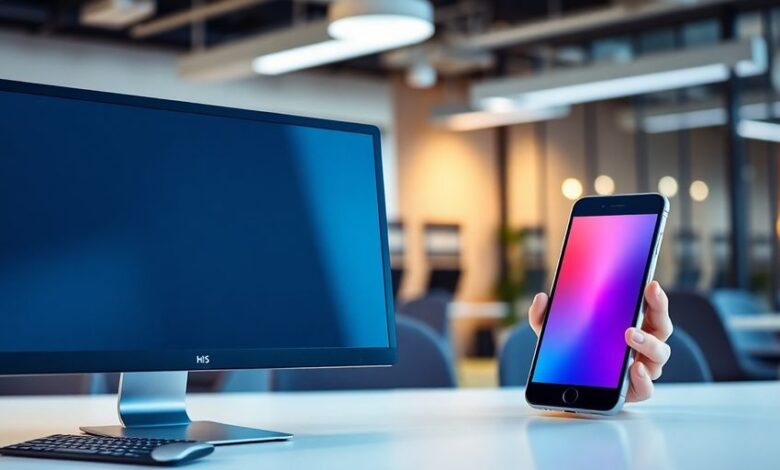
As we look ahead to 2025, the conversation around whether to use desktop or mobile devices for business purposes is heating up. With technology changing rapidly and consumer habits shifting, it’s crucial for businesses to consider which platform will serve their needs best. This article breaks down the current trends, user behaviors, and future possibilities to help you make an informed decision in the debate: desktop or mobile devices for business use.
Key Takeaways
- Mobile devices are becoming the primary way people access the internet, but desktops still hold value for complex tasks.
- User intent differs significantly between mobile and desktop; understanding this can shape content strategies.
- Responsive web design is essential for catering to both mobile and desktop users effectively.
- Security and privacy are major concerns for mobile users, impacting how businesses operate.
- Emerging technologies like AR and VR could change how we use both mobile and desktop in the business landscape.
Understanding Mobile vs Desktop Usage Trends
It’s wild how much things have changed. Remember when desktop computers were the way to get online? Now, it feels like everyone’s glued to their phones. Let’s break down what’s driving these shifts.
Impact of Technological Advancements
Technology keeps pushing the boundaries of what our devices can do. Mobile devices are way more powerful than they used to be. They can handle tasks that once required a bulky desktop. Better processors, faster internet speeds, and improved battery life all play a role. It’s not just about having a smaller computer in your pocket; it’s about having a device that’s actually useful for a wide range of activities. For example, mobile devices account for global web traffic more than desktops.
Changing Consumer Behaviors
People’s habits are changing, plain and simple. We’re always on the go, and we expect to be able to access information and services wherever we are. Mobile devices fit that lifestyle perfectly. Think about it: checking email on the bus, ordering groceries while waiting in line, or catching up on the news during a coffee break. These are all things that used to be done on a desktop, but now they’re mobile-first activities.
Evolving Business Needs
Businesses are adapting to these changes, too. More companies are realizing that they need to have a strong mobile presence to reach their customers. This means optimizing websites for mobile devices, developing mobile apps, and using mobile-friendly marketing strategies. It’s not just about having a website that looks good on a phone; it’s about creating a mobile experience that’s seamless and engaging.
The shift towards mobile isn’t just a trend; it’s a fundamental change in how we interact with technology. Businesses that understand this and adapt accordingly will be the ones that thrive in the years to come.
The Importance of User Intent in The Debate

It’s easy to get caught up in the technical side of things when we talk about desktop versus mobile. But let’s not forget the human element. What are people actually trying to do when they pick up their phone or sit down at their computer? Understanding this is key to making smart choices about where to focus your efforts.
Differences in User Intent
User intent varies significantly between mobile and desktop. Someone on a phone might be looking for a quick answer or directions, while a desktop user could be researching a big purchase. Think about it: are they casually browsing or ready to commit? This difference should shape your content and design choices. For example, mobile users might appreciate a streamlined experience, while desktop users might expect more detailed information.
Content Consumption Patterns
How people consume content also differs. Mobile users often skim and scan, looking for key information on the go. Desktop users, on the other hand, are more likely to settle in and read longer articles or watch videos. Tailor your content to fit these different consumption styles. Short, punchy paragraphs and clear headings work well on mobile, while desktop allows for more in-depth exploration. Consider mobile-first indexing when creating content.
Engagement and Conversion Rates
Engagement and conversion rates can vary wildly depending on the device and the type of product or service. While mobile is great for quick purchases and social media engagement, desktops often see higher conversion rates for complex or high-value items. People might feel more comfortable making a big purchase on a desktop, where they have a larger screen and can see all the details. Understanding these patterns can help you optimize your e-commerce strategy.
It’s not just about having a mobile-friendly website. It’s about understanding why people are using mobile in the first place. Are they looking for information, entertainment, or to make a purchase? Once you know their intent, you can create an experience that meets their needs and drives results.
SEO Strategies for Mobile and Desktop
Responsive Web Design
Responsive web design ensures websites adapt to any device. It’s still the best way to handle both mobile and desktop users. This means your site looks good and works well no matter what screen size someone is using. It also helps Google understand your site better, which can improve your search ranking.
Cross-Device User Experience Testing
Testing how your website works on different devices is super important. You need to make sure everything loads quickly and is easy to use, whether someone is on a phone, tablet, or desktop.
Here’s what to check:
- Loading speed
- Navigation
- Form usability
Make sure your website provides a consistent experience across all devices. This means that users should be able to easily find what they’re looking for, no matter how they access your site.
Advanced Analytics and Segmentation
To really understand how people are using your site, you need to use advanced analytics. This means looking at things like:
- How long people stay on your site
- Which pages they visit
- Where they’re coming from
By segmenting your audience, you can tailor your SEO efforts to meet specific needs. This helps you create content that’s more relevant and engaging for each group.
Security and Privacy Considerations

It’s 2025, and let’s be real, security and privacy are huge deals. We’re talking about sensitive business data, personal information, and the ever-present threat of cyberattacks. It’s not just about having a good password anymore; it’s about building a fortress around your digital assets.
Enhanced Security Measures
Businesses need to step up their game with security. Think multi-factor authentication, advanced encryption, and constant monitoring. It’s not enough to just react to threats; you need to be proactive. Regular security audits and employee training are a must. We also need to consider the evolving threat landscape, with AI-powered attacks becoming more sophisticated. Staying ahead means investing in cutting-edge IT security solutions and expertise.
Privacy Concerns for Mobile Users
Mobile devices are basically mini-computers that we carry everywhere. This means they’re vulnerable to all sorts of privacy breaches. Think about it: location tracking, app permissions, and the risk of data interception on public Wi-Fi. Users are getting smarter about privacy, and they expect businesses to respect their data.
Here’s a quick rundown of what users are worried about:
- Data collection practices
- App permissions
- Location tracking
- Data breaches
Impact on Business Operations
Security and privacy aren’t just IT issues; they affect the whole business. A data breach can damage your reputation, lead to legal trouble, and cost a ton of money. Businesses need to build a culture of security, where everyone understands the importance of protecting data. This includes having clear policies, incident response plans, and ongoing training. It’s about making security a core value, not just an afterthought.
Ignoring security and privacy is like leaving the front door open. It’s only a matter of time before someone walks in and takes what isn’t theirs. Businesses need to take these issues seriously to protect themselves and their customers.
The Role of AR and VR in Business Use
Transforming User Experience
AR and VR are changing how businesses interact with customers and employees. Think about it: instead of just seeing a product online, you could virtually “try it out” in your own home. This level of immersion can significantly impact purchase decisions and brand loyalty. AR and VR are not just for gaming anymore; they’re becoming serious tools for business.
Applications in E-Commerce
E-commerce is getting a major boost from AR and VR. Imagine shopping for furniture and being able to see exactly how a couch would look in your living room before you buy it. Or trying on clothes virtually. This reduces returns and increases customer satisfaction. Here are some specific applications:
- Virtual try-ons for clothing and accessories
- AR overlays to visualize furniture in your home
- Interactive product demos in a virtual showroom
Potential for Training and Development
AR and VR offer exciting possibilities for training and development. Instead of reading manuals or watching videos, employees can learn by doing in a safe, simulated environment. This is especially useful for high-risk or complex tasks. For example, surgeons can practice operations in VR, and technicians can learn to repair equipment using AR overlays. It’s hands-on learning without the real-world consequences.
AR and VR are poised to revolutionize business training by providing immersive, interactive experiences that enhance knowledge retention and skill development. This technology allows for realistic simulations of real-world scenarios, enabling employees to practice and refine their abilities in a safe and controlled environment. The potential for improved learning outcomes and increased efficiency makes AR and VR a game-changer for corporate training programs.
Future Outlook for Desktop and Mobile Devices
Predictions for 2025
Okay, so 2025 is just around the corner. What’s the deal with desktops and mobiles? Well, I think we’re going to see them get even more specialized. Desktops will still be the go-to for heavy-duty tasks, but mobiles? They’re going to be everywhere, doing everything else. Think about it: your phone is already your camera, your wallet, and your personal assistant. That’s only going to increase. The mobile device market will be huge.
Emerging Technologies
AR and VR are going to be big, no doubt. But also, keep an eye on foldable screens and even more powerful mobile processors. These things will blur the lines between what a phone and a tablet can do. And who knows, maybe we’ll even see some new form factors pop up that we haven’t even thought of yet.
- Foldable displays becoming mainstream
- 5G and beyond enabling faster, more reliable mobile experiences
- AI integration improving device functionality
I think the biggest change will be how we interact with our devices. Voice control is already pretty good, but it’s going to get way better. And maybe we’ll even start seeing more brain-computer interfaces. Okay, that might be a bit further out, but you never know!
Long-Term Business Strategies
Businesses need to be thinking about this stuff now. It’s not enough to just have a mobile-friendly website. You need to be thinking about how people are actually using these devices and tailoring your content and services accordingly. That means understanding user intent, optimizing for different screen sizes, and making sure your apps are top-notch. The companies that get this right will be the ones that thrive.
| Device Type | Primary Use Case (2025) | Business Strategy Implication |
|---|---|---|
| Desktop | Complex tasks, content creation | Optimize for productivity, collaboration |
| Mobile | On-the-go, quick access | Focus on convenience, personalization |
Balancing Desktop and Mobile Strategies
It’s not really an either/or situation anymore. The best approach is to figure out how desktop and mobile can work together to create a better experience for your users. It’s about finding the right balance and making sure each platform is used to its full potential.
Integrating Both Platforms
Think of desktop and mobile as two parts of a whole. Your strategy should focus on how they complement each other. For example, someone might research a product on their phone but then complete the purchase on a desktop because they feel more secure. Make sure the experience is consistent across both, so users can easily pick up where they left off. This could mean using cloud services to sync data or offering similar features on both platforms.
Optimizing for Different User Experiences
Desktop and mobile users often have different needs and expectations. Desktop is still great for complex tasks, like data analysis or creating detailed reports. Mobile is better for quick information, social media, and on-the-go tasks. Tailor your content and design to fit these different use cases. A responsive website is a good start, but think about the specific features and content that will be most useful on each device.
Case Studies of Successful Businesses
Let’s look at some examples. Company X saw a 30% increase in conversions by creating a mobile app that complemented their desktop website. The app allowed users to easily track orders and receive notifications, while the website was used for more in-depth product research. Company Y focused on creating a consistent brand experience across both platforms. They used the same colors, fonts, and messaging on their website and mobile app, which helped to build trust and recognition. Company Z saw a big improvement in customer satisfaction by offering personalized support on both desktop and mobile. They used chatbots to answer common questions and provided easy access to live support agents.
Final Thoughts
As we look ahead to 2025, the choice between desktop and mobile devices for business use is still a hot topic. Both have their strengths and weaknesses, and the best option often depends on the specific needs of the business and its users. Mobile devices are great for on-the-go tasks and quick access, while desktops shine in situations that require more detailed work or larger displays. Companies should think about their audience and how they use technology. A balanced approach that considers both mobile and desktop can help businesses thrive in this ever-changing landscape. Ultimately, it’s about finding what works best for your team and your customers.
Frequently Asked Questions
What are the main differences between mobile and desktop usage for businesses?
Mobile devices are great for quick tasks and browsing, while desktops are better for detailed work and multitasking. Each has its own strengths depending on what users need.
How does user intent change between mobile and desktop users?
Mobile users often want quick answers or need to make fast purchases, while desktop users might look for more detailed information and engage in complex tasks.
What SEO strategies should businesses use for mobile and desktop?
Businesses should use responsive web design to ensure their sites work well on both types of devices. They should also test user experiences on different devices and analyze user data to improve their site.
What security concerns should businesses consider for mobile devices?
Since mobile devices handle sensitive tasks, businesses must ensure strong security measures are in place to protect user data without making the devices hard to use.
How can augmented reality (AR) and virtual reality (VR) impact business use?
AR and VR can change how customers shop and learn by providing interactive experiences, especially on mobile devices which are easier to use on the go.
What is the future outlook for mobile and desktop devices in business?
By 2025, we expect mobile usage to keep growing due to better technology and faster internet, but desktops will still be important for certain tasks and industries.




One Comment